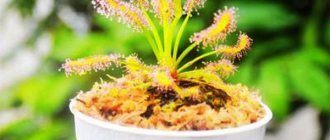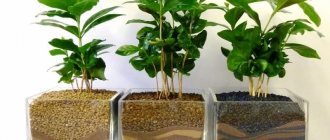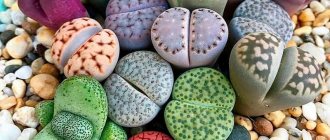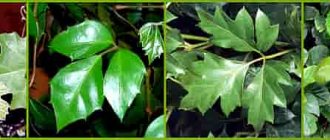Sundew is an amazing plant, considered the most common among carnivorous representatives of the flora. This flower owes its name to the small droplets on the leaves. Thanks to this viscous liquid, the plant hunts. When an insect sits on a flower, it sticks, the dew paralyzes it, and the leaves curl up to digest the prey.
Thanks to the quick reaction, the villi are compressed at an unusually high speed, up to a tenth of a second, thereby leaving the insect no chance of escape. Digestion of food usually occurs over several days.
The uniqueness of the predatory flower is that due to its carnivorous lifestyle, it provides itself with all the necessary microelements, even living in poor soil. Lovers of unusual flowers will enjoy the homemade sundew and will find it attractive for breeding.
This is interesting : the sundew can rightfully be called a smart plant. After all, if a foreign object of inorganic origin gets on the leaves, they do not curl up, and the digestion process will not start.
Botanical description
Sundew belongs to the family of the same name.
The name of the genus contains the Greek word “droseros”, which means “covered with dew” , since drops of sticky secretion can be seen on the glandular hairs of the flower, reminiscent of morning dew sparkling in the sun.
The sundew family includes more than 200 species of plants native to South America, New Zealand, Australia, and South America. Several species of sundews are also found in the northern hemisphere.
Sundews living in the tropics are much larger in size than their northern neighbors. For example, the stem of the giant Australian sundew reaches 1 m in length. And the royal sundew, which grows in South Africa, easily digests toads and snails.
Drosera is a perennial insectivorous herbaceous plant, most often without a stem , but with a creeping rhizome. The root system is well developed, but weak. It is only necessary to absorb water and keep the plant on the soil surface.
Rosette basal leaves are covered with reddish hairs with sticky tips.
By leaf color:
- reddish;
- yellow;
- light green;
- green.
By form:
- small and round;
- long, narrow or wide.
The leaves lie on the ground or sit on petioles, the length of which is 2-15 cm.
On the upper part of the leaf blade there are 25 cilia , with the longest located at the edge.
Sundew blooms in late spring - early summer (2-3 months). The flowers are inconspicuous, small (usually 1.5 cm, but there are species with flowers 4-5 cm in diameter), collected in a brush or panicle.
They are located on long peduncles to prevent pollinating insects from becoming trapped. In most species, flowers open only in the sun.
Fruits in the form of a box with a large number of small seeds appear in August. When the seeds are fully ripe, the fruit opens into 3 parts, they scatter on the soil and germinate successfully a year later.
Interesting facts about the carnivorous plant Sundew.
Carnivorous plants are not poisonous! Moreover, sundews are medicinal plants.
Sundews have been used as medicinal herbs as early as the 12th century, when an Italian physician from the School of Salerno, Mattei Platearius, described the plant as an herbal cough remedy called herba sole. It is widely used in cough preparations in Germany and other European countries. Tea with sundew was especially recommended by herbalists for dry coughs, bronchitis, whooping cough, and aspirin. Modern research has shown that Drosera exhibits antitussive properties. Culbreth's 1927 Materia Medica listed D. rotundifolia, D. anglica and D. linearis as stimulants and expectorants, and for the treatment of bronchitis, whooping cough and tuberculosis. Sundews have also been used as an aphrodisiac and to strengthen the heart, as well as to treat sunburn, toothache, and prevent freckles. Today, sundew is commonly used to treat conditions such as asthma, coughs, lung infections, and stomach ulcers. Medicines are mainly prepared using roots, flowers and leaves. Since all native sundew species are protected in many parts of Europe and North America, extracts are usually prepared using cultivated fast-growing sundews (especially D. rotundifolia, D. intermedia, D. anglica, D. ramentacea and D. madagascariensis) or from plants collected and imported from Madagascar, Spain, France, Finland and the Baltic countries. The drug droserine, obtained from an extract from sundew extracted at low temperatures, is widely known. In folk medicine, sundew found some use: the juice of its glands was used externally to exterminate warts; sundew was used internally as a diaphoretic and diuretic, for fevers, and for eye diseases. In Italy, sundew is used to prepare the liqueur “Rosolio”, and used to be part of the so-called “aqua auri”.
Where does it grow?
The sundew's habitat is peat bogs of various continents, often growing adjacent to shrubs of the heather family.
In the subtropics, the plant grows all year round , while in cooler conditions the flower enters a dormant period and overwinters under the cover of snow. To survive severe drought, members of the family growing on the Australian continent can see underground thickening of roots in the form of a tuber, which helps to cope with unfavorable natural conditions.
How and what does sundew eat?
The fact that a plant is a predator does not mean that it depends only on receiving live food. After all, if there are no insects, the flower feeds like an ordinary plant.
To catch prey, the plant first attracts the insect with the shine of a dew-like droplet, which is actually a sticky digestive enzyme. When the victim touches the leaf, it sticks.
After 10-20 minutes, the eyelash to which the victim is stuck bends towards the center of the leaf. Neighboring cilia also bend, causing the insect to suffocate. At the end of everything, the edge of the sheet plate is bent and the trap slams shut. This plant reaction occurs only to protein foods , while the flower does not react to other substances.
During the digestion of food, the cilia secrete special enzymes that are similar to pepsin (animal stomach juice). With their help, protein is broken down, allowing the plant to eat lunch. When the process is completed, the leaf opens and only the remains of the victim (chitinous shell) can be seen on it. After this, the cilia straighten, become covered with a sticky secretion resembling dew, and again lure a new victim. Sometimes the sundew takes several days to digest its food.
Favorite delicacy of carnivorous plants?
HamstersFlies
How can a plant hunt?
Hunting is the most important aspect of proper nutrition. In order for it to grow quickly, you need to know how it hunts.
- It has special glands.
- Thanks to them, small drops of a substance are produced that attracts insects.
- The petals are completely covered with sticky hairs.
- Having sat on such a petal, the insect sticks to it.
- The plant senses this and curls up.
- The victim falls into a kind of trap.
The insect can remain in such a trap for more than a week, slowly killing its prey. After this, the petal opens and again secretes a sticky substance. Most often, the predator can be seen in swampy areas. It is here that the flower feels a lack of nitrogen, and having caught the victim, the sundew receives the required amount of the substance it lacks. The hunting process is quite exciting, but it is rare.
Varieties and photos
There is a wide variety of varieties of this exotic predator that grow successfully in a variety of conditions. Below are photos, names and descriptions of sundew varieties suitable for propagation and care at home:
Round-leaved
This is the most common winter-hardy sundew species, which is found in peat bogs in the temperate climate zone of Russia, Asia, America and Europe. When growing a wild specimen in potted form, the plant must be supplemented with the soil in which it grew.
The round-leaved sundew has rounded basal leaves on which there are red cilia that secrete sticky mucus.
The length of the flower stem reaches 20 cm.
The plant blooms in mid-summer, blooming small white flowers. The fruits ripen at the end of summer and are a single-locular capsule. Round-leaved sundew reproduces by seeds, which are collected and sown in greenhouses, laid on the surface of moist peat soil.
To survive the cold season, the plant forms special wintering buds in advance, which are hidden in sphagnum moss. When spring comes, the sun warms up and the snow begins to melt, annual shoots appear from the buds. The photo below shows Sundew Roundifolia:
Cape
This is the most beautiful and unpretentious species of predator, which is most often grown at home. Cape sundew grows all year round, easily adapting to any living conditions.
This plant reaches a height of only 12 cm and is characterized by beautiful, elongated lanceolate leaves of a light green or reddish hue. The leaves sit in a dense rosette and on each of them there are red tentacles with a sticky secretion. The Cape sundew takes several days to digest its food. The flower stalks reach 20 cm in height and are crowned with inflorescences of bright pink flowers. You can see what the Cape Rosyanka variety looks like in the photo below:
English
This type of sundew is common in Ukraine, Belarus, Russia, the Caucasus, Central Asia and the Hawaiian Islands, choosing damp, sandy places and sphagnum bogs.
The English sundew reaches a height of 7-25 cm, the length of thin lanceolate leaves, located on long petioles and directed upward, reaches 10 cm. The plant blooms in mid-summer, producing white flowers. The fruit is a single-locular capsule containing grayish-brown seeds. In the photo below is the English Rosyanka variety:
Care
Among all carnivorous plants, sundew is best suited for growing at home, since this plant is easier to care for for beginners. Despite the fact that the flower is demanding on lighting and temperature, at home it is possible to create the most suitable conditions for it. To do this, it is best to plant English sundews in glass vessels or special semi-automatic aquariums. Here the plant will be able to enjoy the high humidity it needs and will not suffer from changing conditions.
Lighting
Bright lighting is the most important when growing sundews, which cannot live even with slight shading. But at the same time, plants cannot tolerate direct sunlight , so they need to be placed on bright, sunny windowsills with diffused lighting. Artificial lighting alone will not be enough for them, but it is welcome as additional lighting.
To compensate for the lack of light in winter, sundews should be placed on southern windows at this time of year, and during active growth - on a western or eastern window.
In winter, the duration of illumination should not be less than 8 hours, and in the spring-summer period - 14 hours.
If the sundew does not have enough light or the lighting is unstable, the plant will quickly tell about it. First signs:
- loss of color;
- change in leaf texture to soft and limp.
The leaves should not be allowed to dry out; the sooner the sundew’s lighting is normalized, the better.
Temperature
Almost all types of indoor sundews feel good at a temperature of 18-23°C. When purchasing a plant, you need to ask in advance what temperature conditions the flower is used to and adhere to these recommendations.
Sundews cannot be grown at the same temperature all year round. During the rest period, it must be reduced to 8-13°C, and an increase of more than 14°C is unacceptable.
The exceptions are the Alice and Cape sundews, which can tolerate a period of rest in the warmth if the lighting regime does not differ from summer. The minimum temperature for heat-loving plants is 7°C, and for cold-resistant plants – 2°C, but it is still better not to allow temperatures to drop below 8°C.
In summer, the plant can be taken out into the fresh air , avoiding drafts and protecting from direct sunlight.
Humidity and watering
Sundews are moisture-loving and cannot tolerate even short droughts. Therefore, it is necessary that the moss and soil contain a sufficient amount of moisture without drying out even in the middle part of the substrate.
It is best to water the flower from below, pouring water into trays, which is drained after some time. Each watering is combined with spraying the soil surface to prevent the top layer of the substrate from drying out.
In the spring-summer period, you need to water the plant once every 3 days, while in winter it is enough to do it once a week, preventing the substrate from drying out.
In regions with high temperature and humidity, sundew can also be grown outdoors .
However, after rain it is necessary to drain excess water from the pot so that the roots do not rot. Sundew feels good only in acidic soil, poor in minerals. To achieve this, you need to use distilled or rain water for irrigation. If you use tap water, you need to draw it in advance and leave it for 1-2 days so that the chlorine settles.
Top dressing
Classic feeding of sundews, like other carnivorous plants, is not carried out. Additional food for this flower are insects, which can be purchased at pet stores. In summer, plants can be exposed to fresh air, where they will independently attract insects (flies, midges, ants).
If there are no insects in the room, then the standard feeding is 2-3 flies per plant , which is enough to give once a week. In winter you can rarely feed. 1 time per month. During this period, the plant stops growing, but does not die.
The flower should not be fed with insects that are too large. The victim can escape, fly away, and the sheet will remain damaged.
Transfer
The sundew is replanted as needed, when the previous container becomes too small for the plant.
Moreover, it is best to choose the classic timing of transplantation (February, March), until the flower “wakes up”. To grow sundews, use wide, flat and low containers with drainage holes, no more than 8 cm in height.
Priming
Different types of soil can be used to grow sundews, but the most popular is peat moss (crushed sphagnum moss) . Before use, it must be washed to avoid causing mold on the plants.
You can also use the following types of soil:
- perlite – a light-colored substrate is used to retain water and allow roots to grow better (you can mix equal parts of peat and perlite);
- coconut fiber - a peat substitute obtained from the husks of coconut shells (before use, you must thoroughly rinse them to remove salts);
- aquatic plant soil - consists of small pieces of ceramic chips that absorb moisture well and act like perlite.
Any soil and material that will be used should always be washed to get rid of salts and minerals that could harm the plant.
Types of sundews
In indoor culture, 3 types of sundews are most often grown, and some of them can even grow in gardens in central Russia.
Round-leaved sundew (Drosera rotundifolia). Wintering species of sundew. At the tops of bare stems up to 20 cm high, small, about 2 cm in diameter, round leaves are formed, covered with pinkish cilia. The flowers of this sundew are simple, white or pinkish, in racemes or curled inflorescences.
Interestingly, round-leaved sundew in the European part of Russia is found in the wild - in swamps and peat bogs. When growing this sundew at home, you need to keep in mind that in winter the plant has a pronounced dormant period. But, under suitable conditions, it can grow in the garden.
Cape sundew (Drosera capensis). The most popular type of indoor sundew, originating from Africa. It has narrow oblong leaves from 3.5 to 8 cm long on an elongated thin petiole. The shade of the leaves is yellow-green or reddish, the cilia are pink or greenish. The flowers of this sundew are pink, several on a stem, each flower lives for about a day.
In winter, Cape sundew enters a dormant period and requires cool keeping.
Filamentous sundew (Drosera filiformis). North American sundew with narrow, erect leaves up to 20 cm high (less commonly, up to 50 cm). The hairs on the leaves are reddish or greenish. The root system of this sundew forms a tuber that can be visible above the soil surface. During flowering, the plant forms a long peduncle, on which 10 small purple-yellow flowers appear. and more.
Several varieties are known, such as California Sunset and Florida Giant, but there are few differences between them.
Round-leaved sundew (Drosera rotundifolia). Photo: pixabay.com
Cape sundew (Drosera capensis). Photo: pixabay.com
Spoon-leaved sundew (Drosera spathulata). Photo: pixabay.com
In stores specializing in rare and carnivorous plants, you can also find less common types of sundews.
Reproduction
Sundew is propagated in several ways:
Cuttings
A leaf is cut from the mother plant and kept in moist sphagnum moss in a greenhouse. Rooting and the appearance of young sprouts wait 2 months, after which the flower is transplanted into a pot. The cuttings can also be rooted in a container of water.
How to grow from seeds?
The collected seeds are sprinkled on the surface of a mixture of peat and sand, then sprayed. Cover with glass or film and keep for 3-5 weeks in bright light and temperature +25°C . They dive when four leaves appear.
Dividing the bush
The rosette extending to the side is separated from the mother liquor and planted in a separate container.
Transplanting sundew at home
Sundews do not need regular replanting; this is done only when urgently necessary, if the plant has outgrown its pot (which happens infrequently) or the substrate has become unusable for one reason or another.
Sundew is transplanted at the end of the dormant period, in February or the first half of March. It is better to work with rubber gloves. The plant is very carefully removed from the pot, trying not to touch the “working” parts of the leaves. The soil is not completely removed from the roots, but only the excess is carefully shaken off. The sundew's root system is usually small, superficial and fragile, so it must be handled very carefully. After transferring to a new pot, the plant should be in the soil at the same depth as before.
Photo: pixabay.com
If you are lucky enough to find a wild sundew, it is best to resist the urge to dig up the plant and plant it in a pot as an indoor plant. Firstly, sundew is a rather rare plant; in the territory of Moscow and some adjacent regions (3) it is listed in the Red Book. Secondly, wild plants are more demanding in terms of maintenance: soil composition, temperature, humidity and wintering conditions, and you will not be able to reproduce the entire complex of natural factors familiar to them at home. Even if a sharp change in conditions does not destroy the plant immediately (which is most likely), it will gradually wither away in the coming months.
Indoor sundews, which have been grown in human habitation for many generations, are much better adapted to them.
Diseases and pests
Sundew is practically not affected by pests, only spider mites and aphids. For spider mites, Actellik is used. When an aphid attacks a plant, the flower stops growing and its leaves and stems become deformed.
Diseases on sundew occur only with improper care:
- Gray rot - first remove all affected areas, and then the plant is treated with fungicides.
- Root rot - the stem and leaves turn black, plant growth slows down - caused by low temperatures and waterlogging of the soil. To save a flower, its rotten roots are cut off, and the plant is transplanted into a disinfected container with new soil.
- There is no sticky secretion on the leaves - it occurs when the soil is unsuitable and the moisture level is low. This can be corrected by replacing the soil and increasing the humidity.
Photo gallery
ravenous_house
artem_kyznetsv
venerina_muholovka
ravenous_house
venerina_muholovka
prozerpinah_lmp











